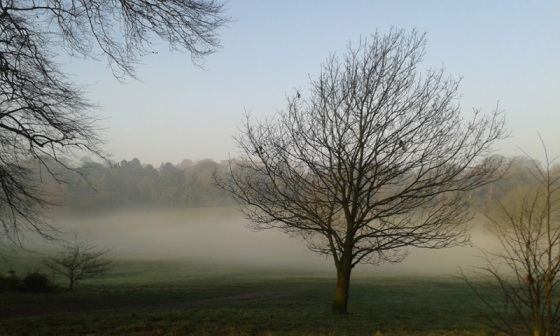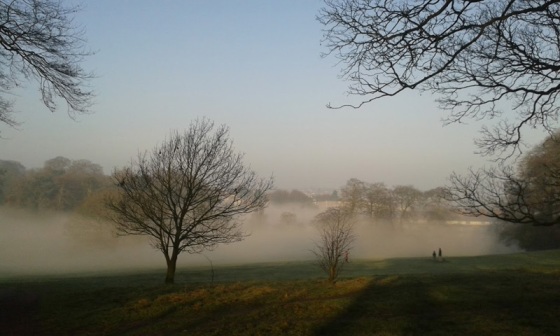
OK…that’s bit foggy. (Warley Woods)
Just a short scrape away from Leeds is St Aidan’s Nature Park – an intriguing place to visit, which was originally an opencast mine for many years. It has since been restored to a nature park with lakes, ponds, meadows, reedbeds, and woodland glades.
From wherever you look in the park, you can always see the huge dragline excavator by the Visitor’s Centre. Known as Oddball, this huge piece of engineering equipment was used in surface mining but is now enjoyed as something of a 1220-ton ornament.
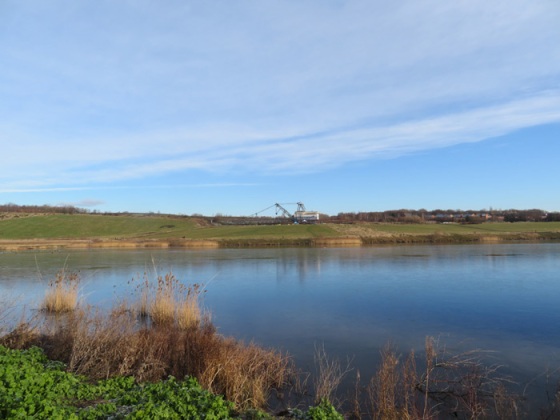
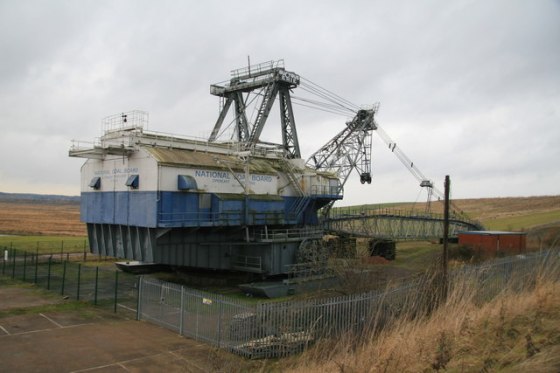
CC by SA – Oddball
Close views of a brave Bearded Tit got the day off to a superb start. The unperturbed reedling (not really a tit – and its not even bearded either, more of a moustache) pinged through the reeds and rushes, and flitted along the frozen surface of the water.

Bearded Tit
As to be expected, there was plenty of waterfowl, including Shoveller, Tufted Duck, Pintail, Teal, Wigeon and Shelduck alongside a supporting cast of Lapwings, Golden Plovers and the odd Snipe. Occasionally a Kestrel hovered into view, and a single Bullfinch zipped overhead.

Bad Hair Day for this Lapwing
As we crackled along the circular frozen paths, a Bittern came floating up above the reedbeds, and in one of the meadows, a lone Bean Goose could be seen waddling behind a tight gaggle of Pink-footed Geese.
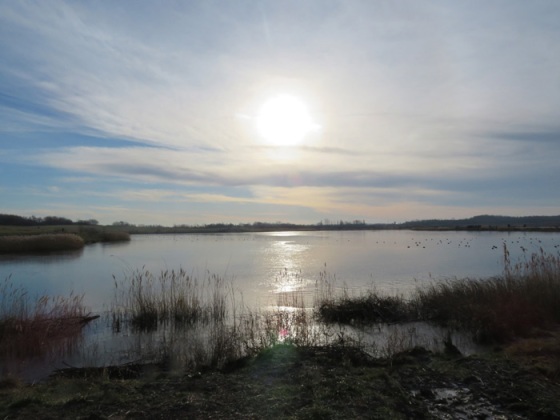
It took a long while before the frozen paths began to thaw, which was just as well with shallow patches of slimy mud to slide through.
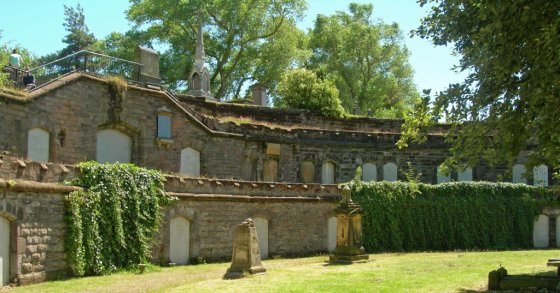
cc-Birmingham City Council
A guided walk around the atmospheric Warstone Lane Cemetery turned up a few snippets of local interest.
At last month’s Film Club, there was a screening of a little feature called Ivor the Engine. Ivor was a popular children’s television programme created and written by Oliver Postgate, who was also responsible for Pogles’ Wood, the Clangers and Bagpuss.
Well, Oliver’s great grandfather John is buried at this cemetery in the Jewellery Quarter. A university professor, John was also a committed food safety campaigner, and his son Raymond founded the Good Food Guide.
The major feature of this cemetery is the two tiers of catacombs, whose unhealthy vapours brought about the Birmingham Cemeteries Act, which insisted on non-interred coffins being sealed with lead or pitch.

Birmingham Conservation Trust
John Baskerville is one of the more notable residents in the cemetery, a businessman best remembered as a printer and type designer.
Another gem is Harry Gem who pioneered lawn tennis and whose memorial has been given a recent makeover, having previously been little more than a lichen-clad slab on the ground.
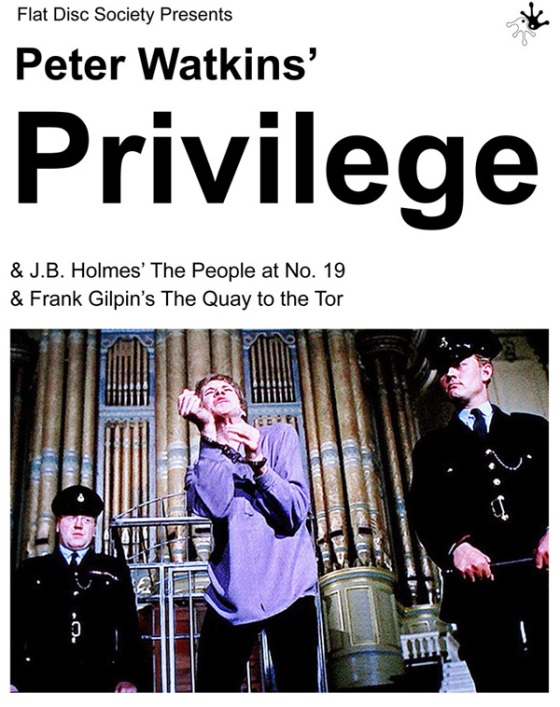
On 13th February 2019, UNESCO celebrated the 8th edition of World Radio Day with the theme of “Dialogue, Tolerance and Peace”.
February’s Flat Disc evening was a triple-bill of films with radio as its connecting theme. First up was The People at No. 19 – a Central Office of Information and Ministry of Health film, followed by The Quay to the Tor, a travelogue of South Devon featuring the voice of ex-Doctor Who Jon Pertwee. The main feature was Privilege, starring Paul Jones, a satire from 1967 predicting mass media being subverted as propaganda.
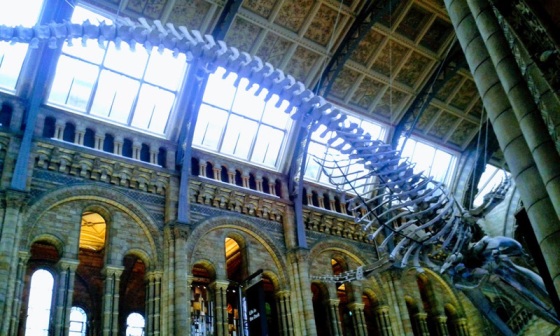
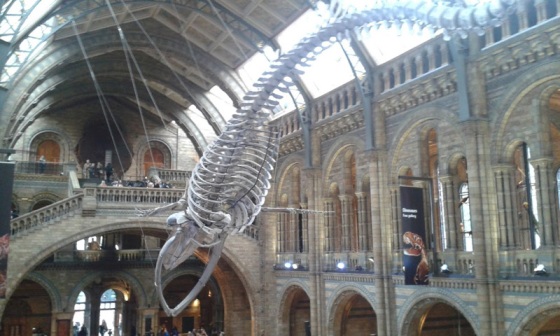
Dippy’s replacement…
When in London, it borders on heresy not to visit the splendid Natural History Museum, and when your hotel is only about the length of a couple of Plesiosaurs away, it is simply unforgiveable not to pop in for a look around.
It is all too easy to become overwhelmed by the masses of exhibitions – the building itself is worthy of its own pedestal – but once past the main hall with the Blue Whale skeleton dangling from the ceiling, some great little treasures can be found tucked away in a side gallery.
The Cadogan Gallery is one such trove with fascinating items ranged across a variety of scientific disciplines. Gathered here is a selection of the many wondrous things that can be found amongst the museum’s vast collection of natural wonders.
The most valuable fossil in the museum can be found in this corner of curiosities – the archetypal Archaeopteryx, the staple illustration from many a school kid’s first book on dinosaurs. This was the feathered clincher than suggested birds evolved from dinosaurs.
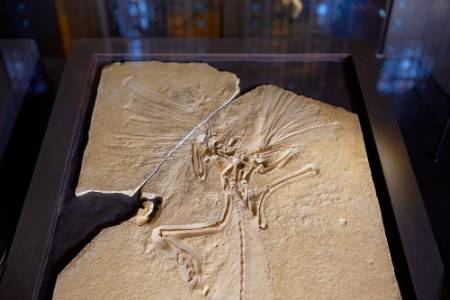
On display are some original images from John James Audubon’s Birds of America book, and a rare first edition of Charles Darwin’s On the Origin of Species.
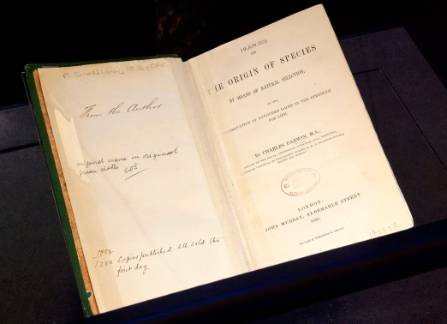
Darwin’s theory of evolution by natural selection was co-discovered by Alfred Russell Wallace, and an insect case from Wallace’s personal collection is also on view.
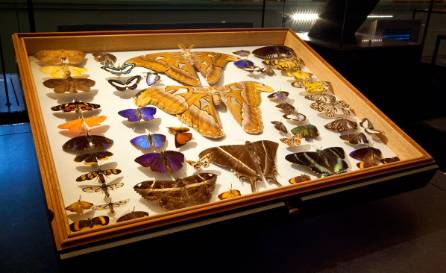
Other startling artifacts are ranged across the gallery – an Emperor Penguin’s egg, one of the three recovered from Scott’s ill-fated expedition to the South Pole; the skull of an extinct Barbary Lion, found during Tower of London excavations – the oldest lion found in the UK after the extinction of native wild lions. There were dinosaur teeth too – the first things to tell us dinosaurs once roamed Earth, and a skeleton of a Dodo, and even a chunk of Moon Rock. It’s all heady stuff!
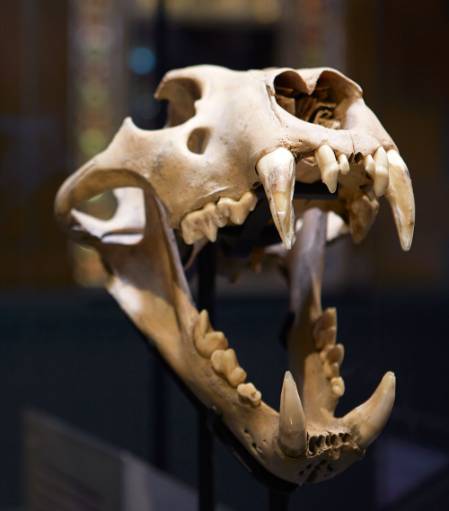
These photos are from the museum website, plus this little clip of other little treasures on show:
Just up the road from the Natural History Museum, the Royal Geographic Society was showcasing Steve Russell’s Mountains of the Moon exhibition in a series of stunning wildlife and landscape images from the Rwenzori Mountains, a jagged range of peaks between Uganda and the Democratic Republic of the Congo. I remember seeing them when travelling through Africa many moons ago!
There was time for a flying visit to St Martin-in-the Fields church on the corner of Trafalgar Square.
A church was originally built on the site of St Martin’s in 1222. Then Henry VIII built a new church on the site and extended the parish boundaries to keep plague victims in the area from having to pass through his Palace of Whitehall. At this time, it was literally “in the fields,” an isolated position between the cities of Westminster and London.
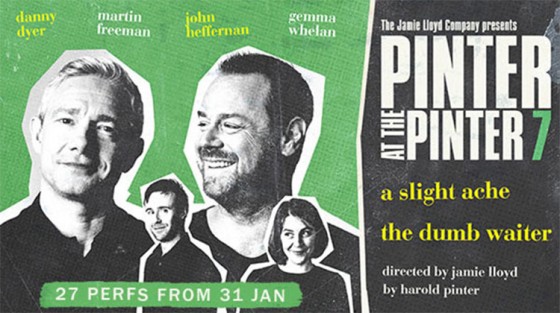
Then it was time for Pinter at the Pinter, a double bill from the late fifties showing as part of the Pinter Seven season.
Harold Pinter’s first radio play, A Slight Ache (1958), starring John Heffernan and Gemma Whelan was first up followed by The Dumb Waiter (1957) with Danny Dyer and Martin Freeman.
Both plays were short and snappy and didn’t seem to date – Martin Freeman’s character even mentioned Aston Villa losing at home so it’s well up to speed.
Here’s the edited five-star review from Michael Billington of the Guardian:
The season of Harold Pinter’s one-act plays comes to a glorious climax with two of his earliest pieces. The pairing of Danny Dyer and Martin Freeman in The Dumb Waiter (1957) guarantees a pre-sold hit. But it is Jamie Lloyd’s production of a lesser-known radio play, A Slight Ache (1959), with John Heffernan and Gemma Whelan from Game of Thrones that provides a genuine shock and surprise.
The Dumb Waiter is a classic study of two gunmen nervously awaiting instructions in the bleak basement of a Birmingham restaurant. Gus, an anxious hitman, asks endless questions while the senior partner, Ben, obeys orders. In Lloyd’s production, even the dumb waiter comes crashing down with the force of a guillotine.
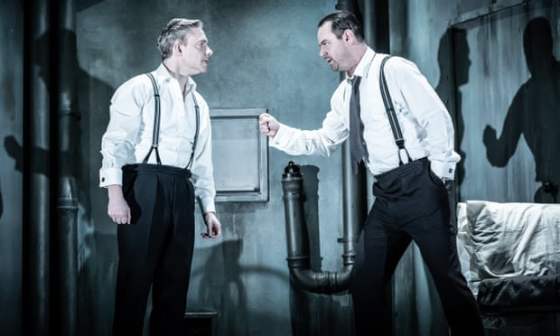
Photo: Marc Brenner
The play is a joy for actors. Freeman avoids the temptation to make the fretful Gus overtly comic: instead he gives us a dapper organisation man, aware that something is not quite right. Dyer, with his looming physique, is the perfect epitome of fake assurance as he rubs his sweaty palms on his thighs. The beauty of this production is that it shows both men are aware that they are part of a hierarchy of terror.
A Slight Ache has Heffernan and Whelan initially sitting at microphones as they play a comfortably middle-class couple, Edward and Flora, having a mild spat over the breakfast table. But the action hinges on the intrusion into their lives of an old match-seller who exposes the precariousness not just of their marriage but of their whole existence.

Marc Brenner
These two plays conclude a season that has been full of discoveries, reminding us that Pinter had a unified imagination. It has demolished the myth that one-act plays, like short stories, are an inferior form. In Pinter’s hands they are as richly fulfilling as many an inordinate three-hour epic.
With Danny Dyer having recently discovered his right royal roots in a BBC ancestry programme – his bloodline being traced back to William the Conqueror and Edward III – it seemed pertinent to visit some of his family during quick shunt around the National Portrait Gallery. There was only enough time to check out the Tudor and Stuart galleries in which to pay suitable homage to Danny’s kin.
However, statistically we’re all descended from royalty – it’s all in the maths with some experts reckoning that 80% of England’s present population descends from Edward III.
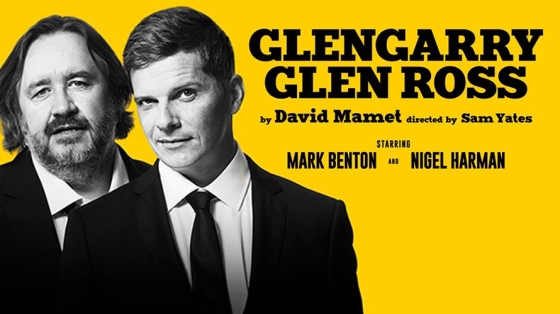
Back in Brum, there was more theatre action at the Alexandra with the very sweary Glengarry Glen Ross.
Yet again, a review is lazily plucked and brutalised from the local papers – this one by Euan Rose for the Bromsgrove Standard:
Glengarry Glen Ross comes to the Alex in its entire West End splendor – a brilliant cast, outstanding sets, and powerful direction.
It shows us the raw underbelly of the nasty world of American real estate back in the 1980s before the big crash.
The ‘Glengarry Glenn Ross’ are poor areas of real estate being marketed as top notch by four salesmen of various levels of success and competence who work for the same company and are prepared to lie, bribe, intimidate and even engage in criminality to make a sale.
Act One opens literally with a bang as the lights snap up in a well worn Chinese restaurant which is so real you could be somewhere next door to the Alex in Birmingham’s Chinatown (they even have the same timeless wallpaper).
The American dialogue bangs in too, Mark Benton plays the overweight, past his sell-by-date Shelly Levene, with Scott Sparrow playing the emotionless office manager. Denis Conway plays angry salesman Dave who is attempting to cajole George (Wil Johnson) into breaking into the office at night and stealing all the sales leads, which he has already pre-sold to a rival company.
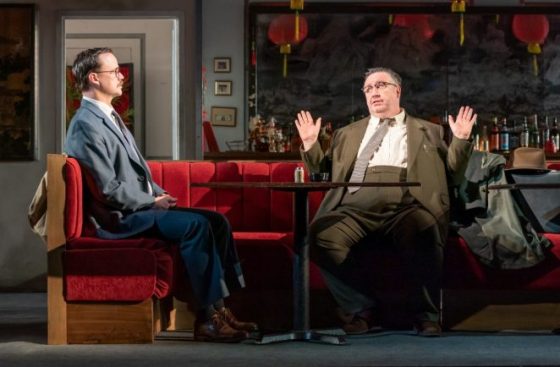
Nigel Harman is the oily salesman Ricky Roma, and client James Staddon plays his innocent target.
Act Two is an equally impressive setting – a cheap tired office, which reeks of stale smoke and sweat where our nest of vipers conduct their business.
There are piles and piles of boxes, which literally go up to the ceiling, desks buried in phone directories and papers, open filing cabinets and wallboards with old notices pinned to them in bundles. So great is the clutter that we can be forgiven that it is only when we meet the police detective who comes out of the interview room that we learn there has been a robbery the night before and yes the coveted sales leads have gone!
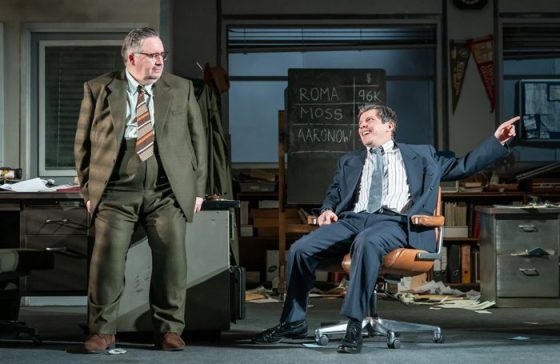
The all male cast is seven-strong, all simply superbly cast and played to perfection.
I felt in the presence of something very special – it’s not the first time I’ve seen this play or indeed the film but it is by far the best.
There was a bonus in the pub afterwards when we met and chatted (somewhat briefly) with a very agreeable Mark Benton…
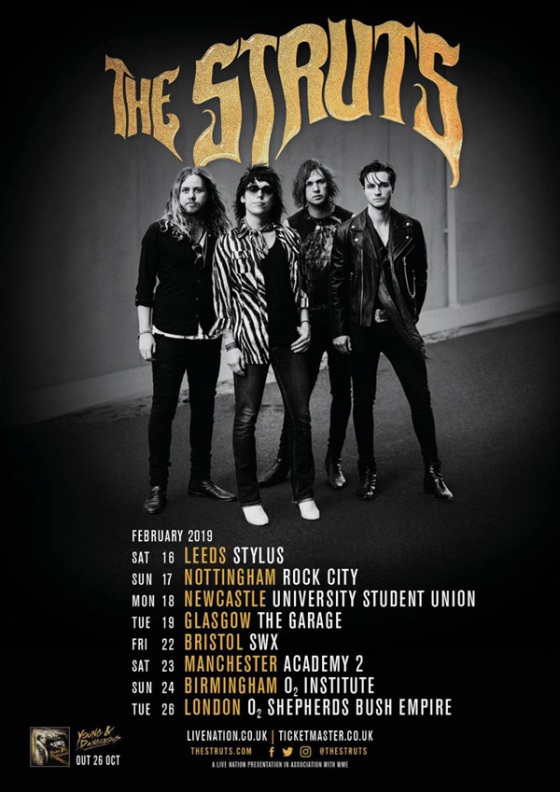
Some tunes were needed to see out the month, and a trip to the Birmingham Institute to see Dave Grohl’s favourite support band – the brilliant Struts fulfilling all musical expectations with a barnstorming set that required several ales to be quaffed along the way.
Support was by the Overlaps.
Now for a cribbed review by Andy Thorley of Maximum Volume Music:
Occasionally you might as well start with the obvious. So here is the inescapable fact: The Struts are going to be huge.
The Struts think they’re huge already. They’re rock stars. We are told that rock is dead; we are told that no one likes showmanship anymore and everything has to be hip.
No one told Luke Spiller. The Struts frontman is the sort of fella that goes to Tesco’s in a fur coat and dark glasses. A man who doesn’t walk, he flounces. He does all this in a pair of multi-coloured spandex trousers – with tassels on.
Right from the off, ‘Primadonna Like Me’ is as if someone has distilled every rock n roll cliché down to its absolute best bit and injected The Struts with it.
Spiller is like a cross between Freddie Mercury, Steven Tyler and Noel Fielding. There’s a reason that Guns N Roses, The Stones and The Foo Fighters are just some of the bands that they’ve opened for.
‘Mary Go Round’ does that thing that many bands do where they light the room with mobile phone torches, but it is ‘Dancing In The Dark’ which becomes the centrepiece – even getting a young lady from the first row to do the Courtney Cox thing.
Spiller is soon wearing another outfit – about his fifth – as they play ‘Could Have Been Me’ to end things.
The Struts are a colourful explosion of unashamed and unabashed rock ‘n’ roll – they are out there, they are loud and they are very, very proud!

To finish February, another atmospheric photo of Warley Woods, taken early one morning before the unseasonably warm weather (the hottest February on record) burned through the mist.
